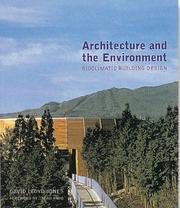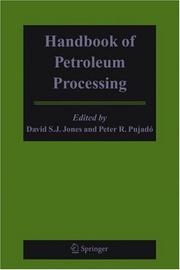| Listing 1 - 3 of 3 |
Sort by
|

ISBN: 1856691039 9781856691031 Year: 1998 Publisher: London Laurence King
Abstract | Keywords | Export | Availability | Bookmark
 Loading...
Loading...Choose an application
- Reference Manager
- EndNote
- RefWorks (Direct export to RefWorks)
Sustainable building has commonly been seen as separate from mainstream architecture and has been accorded the status of worthy but dull design. Adopting the term "bioclimatic" in preference to "green" to describe buildings which are inspired by nature and have a clear strategy for minimizing environmental depredation, this book seeks to revise this judgement. Introductory chapters trace the history of bioclimatic design in architecture, exploring the relationship between architecture and the natural environment. An examination of three projects currently under construction points to future directions in bioclimatic architecture. The contemporary projects featured in the main section of the book are diverse - from office buildings which flaunt their measures for energy conservation in the form of external solar shading, wind towers, glazed atria and photovoltaic modules, to a church built from tubes of recycled paper and a museum constructed in timber and inserted in a woodland setting. Architects whose work is featured include Tadao Ando, Shigeru Ban, Edward Cullinan, Foster and Partners, Herzog and Partners, Glenn Murcutt and Arata Isozaki.
General ecology and biosociology --- energie (technologie) --- environments [object groupings] --- Architecture --- hedendaagse architectuur --- milieu --- Architecture et climat --- Constructions solaires --- Aspect environnemental --- Duurzaam bouwen --- Architectuur --- Architecture, Modern --- 72.036 --- 504 --- Architectuur en milieu ; 1980-1997 --- Architectuur ; klimatisch geregelde ; energiebesparing --- Architectuur ; zonne-energie ; zonneboilers --- 72:574 --- Environmental aspects. --- Twintigste eeuw (architectuur) --- 20ste eeuw (architectuur) --- Duurzame architectuur --- Ecologisch bouwen --- Architectuur en ecologie --- History --- Building materials. Building technology --- sustainable architecture --- Structural parts and elements of building --- Environmental aspects --- Modern [style or period] --- architecture [object genre] --- 574 --- 699.86 --- Ecologie en bioverscheidenheid --- Klimaatontwerp

ISBN: 9781402028199 9781402028205 Year: 2006 Publisher: Dordrecht Springer Netherlands
Abstract | Keywords | Export | Availability | Bookmark
 Loading...
Loading...Choose an application
- Reference Manager
- EndNote
- RefWorks (Direct export to RefWorks)
This valuable reference targets research chemists and engineers who have chosen a career in the complex and essential petroleum industry, as well as other professionals just entering the industry who seek a comprehensives and accessible resource on petroleum processing. The handbook describes and discusses the key components and processes that make up the petroleum refining industry. Beginning with the basics of crude oils and their nature, it continues with the commercial products derived from refining and with related issues concerning their environmental impact. At its core is a complete overview of the processes that make up a modern refinery, plus a brief history of the development of processes. Also described in detail are design techniques, operations, and, in the case of catalytic units, the chemistry of the reaction routes. These discussions are supported by calculation procedures and examples, which enable readers to use today's simulation-software packages. The handbook also covers off-sites and utilities, as well as environmental and safety aspects relevant to the industry. The chapter on refinery planning covers both operational planning and the decision making procedures for new or revamped processes. Major equipment used in the industry is reviewed along with details and examples of the process specifications for each. The second part comprises a glossary and dictionary of the terms and expressions used in petroleum refining, plus appendices supplying data such as converging factors and selected crude oil assays, and an example of optimizing a refinery configuration using linear programming. Handbook of Petroleum Processing is an indispensable desk reference for chemist and engineers and also an essential part of the libraries of universities with a chemical engineering faculty and oil refineries and engineering firms performing support functions or construction.
Book

ISBN: 9783034605007 9783034604994 9783034605069 Year: 2010 Publisher: Basel Springer Basel
Abstract | Keywords | Export | Availability | Bookmark
 Loading...
Loading...Choose an application
- Reference Manager
- EndNote
- RefWorks (Direct export to RefWorks)
on constant tectonic loading are as good as or better Other geophysical measurements may also bere- than time-varying earthquake likelihood models ted to earthquake occurrence, and such relationships determinedfrom the evolving stress ?eld. are examinedin some of the papers herein. ITABA et al. One approach to understanding earthquakes isto compare groundwater and crustal deformation to create synthetic earthquake catalogues using certain seismicity recorded on newly installed stations to test assumptions regarding the physics of the process to previouslyobserved preseismicchanges inShikoku see what features of real catalogues can be explained and theKii Peninsula prior to earthquakes in Tonankai by variations in physical properties. SMITH and and Nankai, Japan. They ?nd strainchanges due to DIETERICH takethis approach and model aftershock slow slip events on the plate boundary, but do not ?nd sequences using 3-D stress heterogeneity in the form signi?cant changes in groundwater at that time. of Coulomb static stress change analysisand rate- We conclude the volume with another comparison state seismicity equations calculatedin regions of of seismicity and GPS. OGATA compares anomalies of geometrically complex faults. Their syntheticmodels seismic activity with transient crustaldeformations match severalfeatures of real catalogues such as preceding the 2005 M 7.0 earthquake west of - earthquakeclustering and Omoridecay,and the kuoka, Japan, concluding that aseismicsliptriggered presence of earthquakes in regions where simpler changes in seismicity rates as well as in GPS record- Coulomb stress modelling predicts stress shadows'' ings during the ten years leading up to the earthquake.
Geology. Earth sciences --- aardbevingen --- geografie --- geologie --- aarde (astronomie)
| Listing 1 - 3 of 3 |
Sort by
|

 Search
Search Feedback
Feedback About UniCat
About UniCat  Help
Help News
News